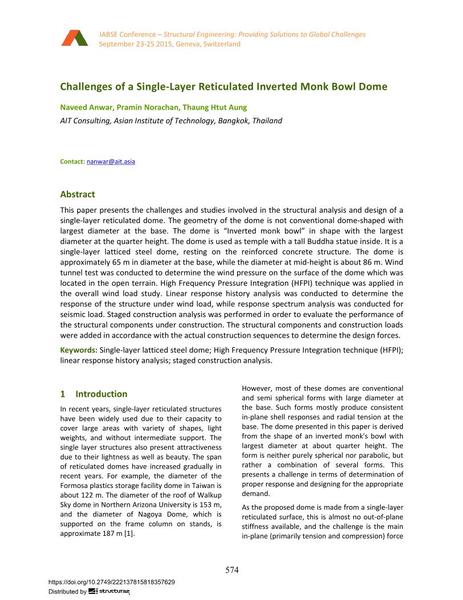Challenges of a Single-Layer Reticulated Inverted Monk Bowl Dome

|
|
|||||||||||
Bibliografische Angaben
| Autor(en): |
Naveed Anwar
(AIT Consulting, Asian Institute of Technology, Bangkok, Thailand)
Pramin Norachan (AIT Consulting, Asian Institute of Technology, Bangkok, Thailand) Aung Thaung Htut (AIT Consulting, Asian Institute of Technology, Bangkok, Thailand) |
||||
|---|---|---|---|---|---|
| Medium: | Tagungsbeitrag | ||||
| Sprache(n): | Englisch | ||||
| Tagung: | IABSE Conference: Structural Engineering: Providing Solutions to Global Challenges, Geneva, Switzerland, September 2015 | ||||
| Veröffentlicht in: | IABSE Conference Geneva 2015 | ||||
|
|||||
| Seite(n): | 574-584 | ||||
| Anzahl der Seiten (im PDF): | 11 | ||||
| Jahr: | 2015 | ||||
| DOI: | 10.2749/222137815818357629 | ||||
| Abstrakt: |
This paper presents the challenges and studies involved in the structural analysis and design of a single-layer reticulated dome. The geometry of the dome is not conventional dome-shaped with largest diameter at the base. The dome is “Inverted monk bowl” in shape with the largest diameter at the quarter height. The dome is used as temple with a tall Buddha statue inside. It is a single-layer latticed steel dome, resting on the reinforced concrete structure. The dome is approximately 65 m in diameter at the base, while the diameter at mid-height is about 86 m. Wind tunnel test was conducted to determine the wind pressure on the surface of the dome which was located in the open terrain. High Frequency Pressure Integration (HFPI) technique was applied in the overall wind load study. Linear response history analysis was conducted to determine the response of the structure under wind load, while response spectrum analysis was conducted for seismic load. Staged construction analysis was performed in order to evaluate the performance of the structural components under construction. The structural components and construction loads were added in accordance with the actual construction sequences to determine the design forces. |
||||
